Olympus Zuiko 9-18mm f/4-5.6 ED
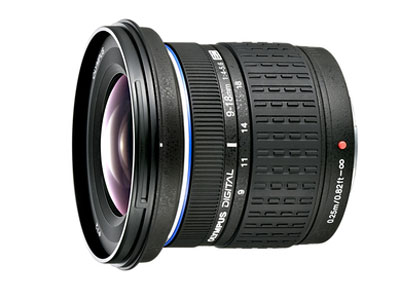 This lens costs around £480 and is possibly the smallest and lightest interchangeable lens available covering this angle of view. |
Olympus also offer two other ultra-wide angle lenses. Their 11-22mm f/2.8-3.5 isn't as wide, but offers a bright maximum aperture for around £735. At the top of their ultra-wide range is their 7-14mm f/4 lens, which offers an angle of view equivalent to a 14-24mm lens on a full frame camera and costs around £1500.
Sigma are the only third-party lens manufacturer offering lenses to fit the four thirds system. Their 10-20mm lens isn't as wide as this 9-18mm lens and is much larger in size, although for around £400 the lens offers a silent focusing motor.
Olympus Zuiko 9-18mm f/4-5.6 ED: Handling and features
Describing this lens as compact and lightweight just doesn't seem enough. Weighing only 280g, and only 73mm long, this lens is exceptionally small for an ultra-wide angle lens, making it a perfect for Olympus' smaller E-series bodies such as the E-400, E410 or E-450.
The lens barrel is almost entirely constructed from lightweight plastic, with the only metal part being the mount. Despite the lightweight construction, the build is more than acceptable, striking a good balance between keeping the weight down and durability. The fit and finish is good, although this is certainly not a professional grade optic.
Auto focus is quick as you would expect with a short focal length lens such as this. The focus motor is clearly audible, but not so loud that it will be disturbing for most people. During AF the focus ring does not rotate, which is a nice touch as there is no danger of catching your fingers with it. The manual focus ring adjusts the focus electronically, rather than mechanically. I found the system easy enough to use when using the camera's AF system to confirm focus.
Olympus Zuiko 9-18mm f/4-5.6 ED: Performance
For this review, the lens was tested on a 12Mp Olympus E-30 using Imatest.
At 9mm, this lens is capable of producing images with excellent resolution at moderate apertures. Wide open, the lens performs acceptably, but stopping down to f/8 produces images with excellent centre sharpness. Unfortunately the resolution towards the edge of the frame never exceeds good on our scale, and it just reaches this level at f/8.
When the lens is zoomed to 14mm, the quality across the frame improves at wider apertures. f/8 will still yield the best overall quality with excellent sharpness in the centre, and very good levels of resolution towards the edges. By 18mm the performance of this lens still holds up well with the best sharpness in the centre being achieved at f/8, but with the highest quality across the frame yielded at f/11.
In the scope of the four thirds format, f/8 should provide enough depth of field for most landscape applications, so the performance here is very good for these kinds of applications.
Click on the thumbnail for the larger image.
| Resolution at 9mm |
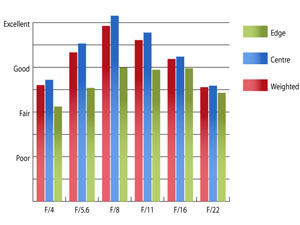 |
| Resolution at 14mm |
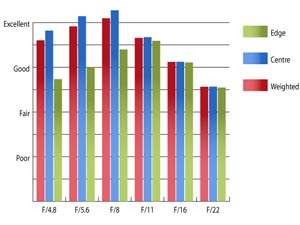 |
| Resolution at 18mm |
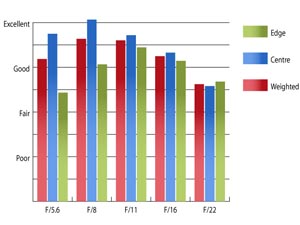 |
Between 9mm and 14mm, Chromatic Aberratons are extremely well-controlled, with Imatest barely being able to detect over a quarter of a pixel width of colour fringing during testing. As the lens is zoomed in further the performance in this area tends to deteriorate. At 18mm colour abberations exceed 1.25 pixel widths at f/5.6, which may start to become noticeable in high contrast scenes. Stopping down only makes matters worse, in fact I had to alter the scale on the CA graph to fit the reading toward the edge of the frame on there as it exceeds 4.25 pixel widths.
Click on the thumbnail for the larger image.
| Chromatic Aberrations at 9mm |
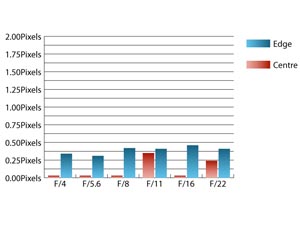 |
| Chromatic Aberrations at 14mm |
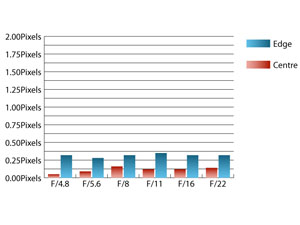 |
| Chromatic Aberrations at 18mm |
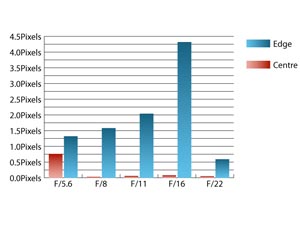 |
For an ultra-wide lens, the Olympus 9-18mm displays good peripheral illumination. At 9mm the far corners are only 1.4stops darker than the image centre and stopping down the f/5.6 results in pretty much even illumination. At 18mm, any sign of vignetting has decreased further, with the corners only 0.4 stops darker than the image centre at f/5.6.
Click on the thumbnail for the larger image.
 |
 |
Barrel distortion at the wide end is typical for this kind of lens, with Imatest recording a value of 3.96%, which will be noticeable in images where straight lines are important. This should be relatively easy to correct in image editing software afterwards due to the uniform shape of the distortion. Zooming to 18mm reduces the level of barrel distortion to 0.59%, which is a more more acceptable level and shouldn't pose many issues for most.
Flare and ghosting is very well controlled by this optic. Neither strong point sources of light in, or outside the frame cause any issues. Contrast is retained even with a strong light source beside the front element of the lens and out of the image area and although a petal-shaped lens hood is provided, I feel it will rarely be necessary. This is exceptional performance for a lens of this kind.
Olympus Zuiko 9-18mm f/4-5.6 ED: Verdict
 These who like to travel light, but can't be without an ultra-wide zoom will love this lens. It's capable of producing excellent results at moderate apertures, is incredibly resistant to flare and ghosting and isn't priced too highly either.
These who like to travel light, but can't be without an ultra-wide zoom will love this lens. It's capable of producing excellent results at moderate apertures, is incredibly resistant to flare and ghosting and isn't priced too highly either.Olympus Zuiko 9-18mm f/4-5.6 ED: Pros
 Compact, lightweight design
Compact, lightweight design Excellent resolution at f/8 throughout the zoom range.
Excellent resolution at f/8 throughout the zoom range. Excellent resistance to flare and ghosting
Excellent resistance to flare and ghosting Fast AF
Fast AFOlympus Zuiko 9-18mm f/4-5.6 ED: Cons
 Chromatic Aberrations at 18mm
Chromatic Aberrations at 18mm Resolution towards the edge of the frame at 9mm
Resolution towards the edge of the frame at 9mm| FEATURES |  |
| HANDLING |  |
| PERFORMANCE |  |
| VALUE FOR MONEY |  |
| OVERALL |  |
Olympus Zuiko 9-18mm f/4-5.6 ED: Lens specification
| Price: | £469 |
| Contact: | http://www.olympus.co.uk |
| Filter size: | 72mm |
| Format: | Four Thirds |
| Construction: | 13 elements in 9 groups |
| Angle-of-view: | 100° - 62° |
| 35mm equivalent focal length (on Four Thirds body): | 18-36mm |
| Internal focusing: | Yes |
| Image stabilisation: | No |
| Minimum focus: | 25cm |
| Maximum aperture: | f/4-5.6 |
| Minimum aperture: | f/22 |
| Weight: | 280g |
| Size (lxw): | 73mm x 79.5mm |
| In the box: | Lens Hood |
The Olympus Zuiko 9-18mm f/4-5.6 ED costs £469 and is available from Warehouse Express here:
Olympus Zuiko 9-18mm f/4-5.6 ED
Add your message
Login required
Please login here or if you've not registered, you can register here. Registering is safe, quick and free.
Please login here or if you've not registered, you can register here. Registering is safe, quick and free.
photodo Stats
1102 lenses
428 MTF tests
74 in-depth photodo reviews
100+ users join each day
Help the lens community by reviewing or rating a lens today via our lens search
428 MTF tests
74 in-depth photodo reviews
100+ users join each day
Help the lens community by reviewing or rating a lens today via our lens search
Latest Lens Reviews
- Chinon 28mm f/2.8 Vintage Lens Review
- Canon EF 70-200mm f/4L IS II USM Lens Review
- Samyang AF 85mm f/1.4 EF Review
- Sigma 70mm f/2.8 DG Macro Art Review
- Samyang AF 24mm f/2.8 FE Review
- Meike 50mm f/1.7 Review
- Tamron 70-210mm f/4 Di VC USD Review
- Lensbaby Burnside 35mm f/2.8 Review
- Asahi Super Takumar 50mm f/1.4 Review
- Asahi Super-Multi-Coated Takumar 135mm f/3.5 Review
